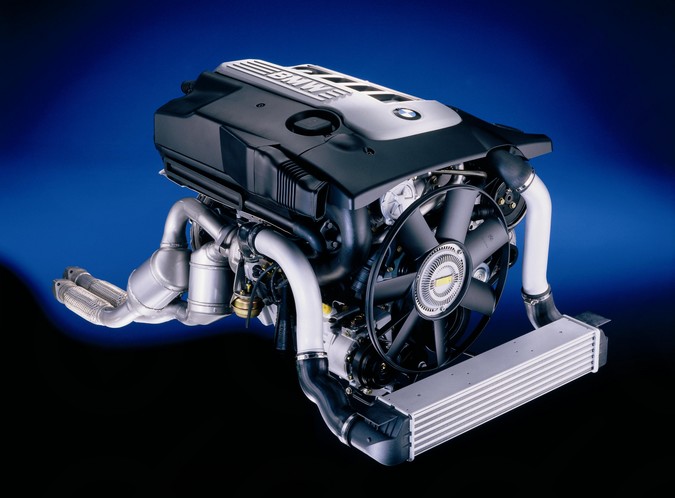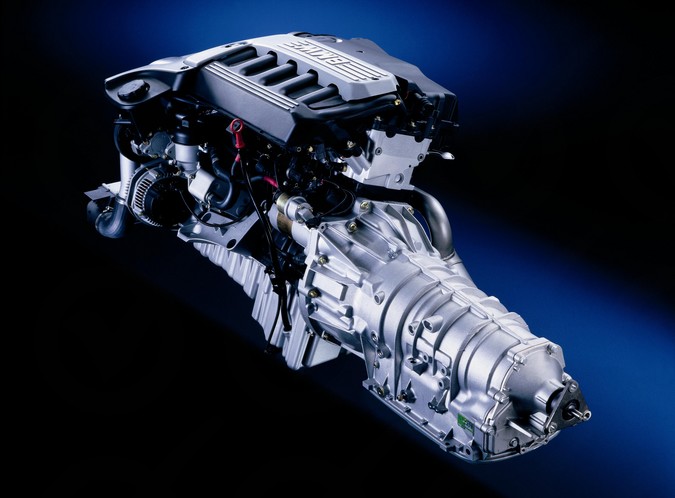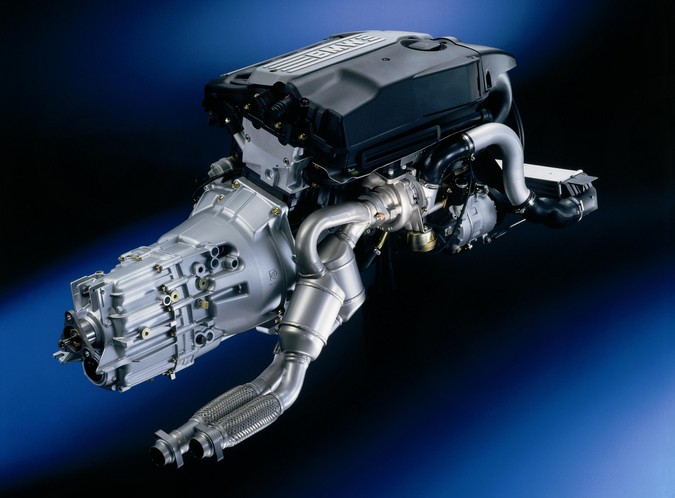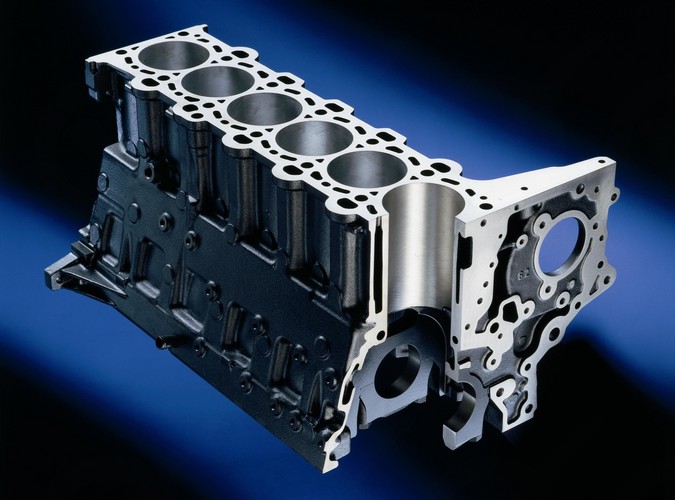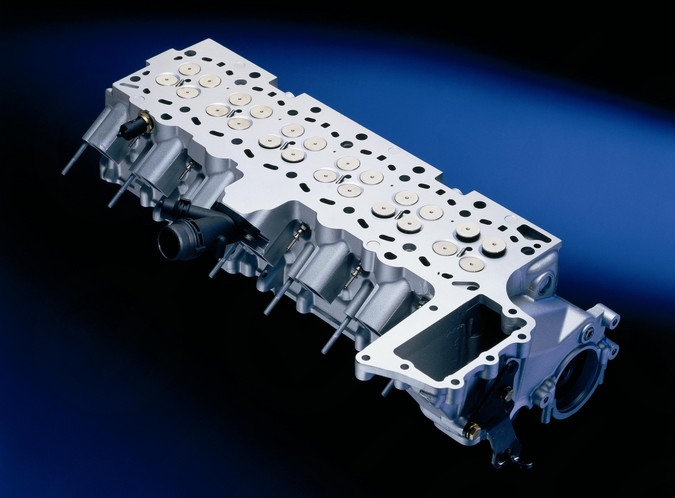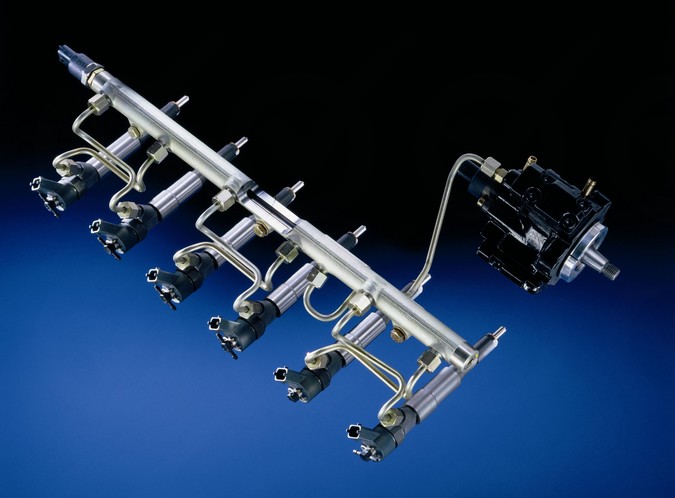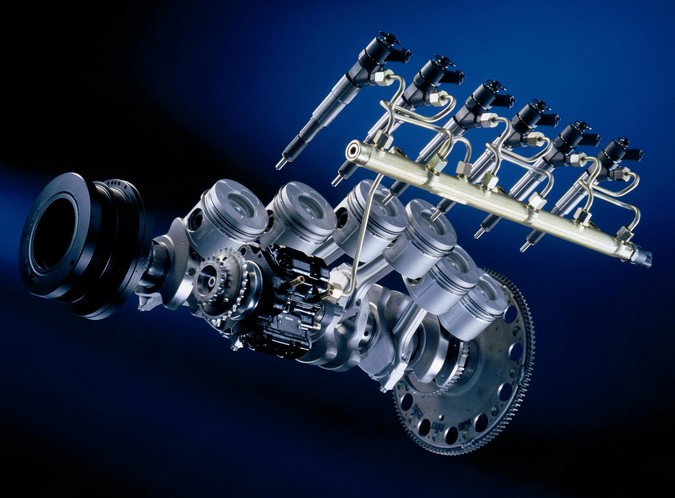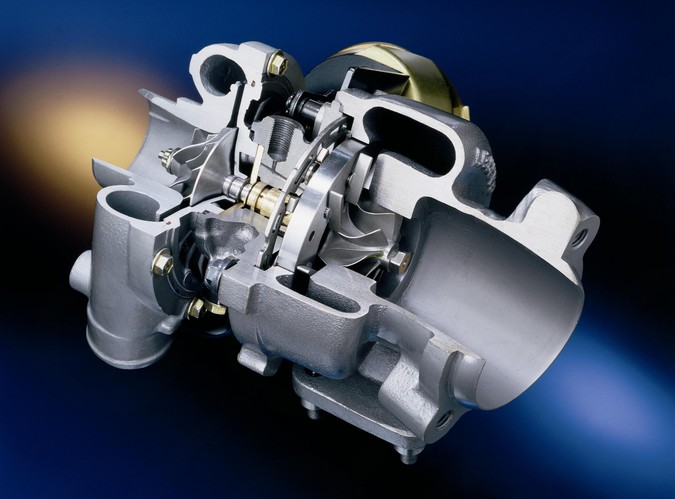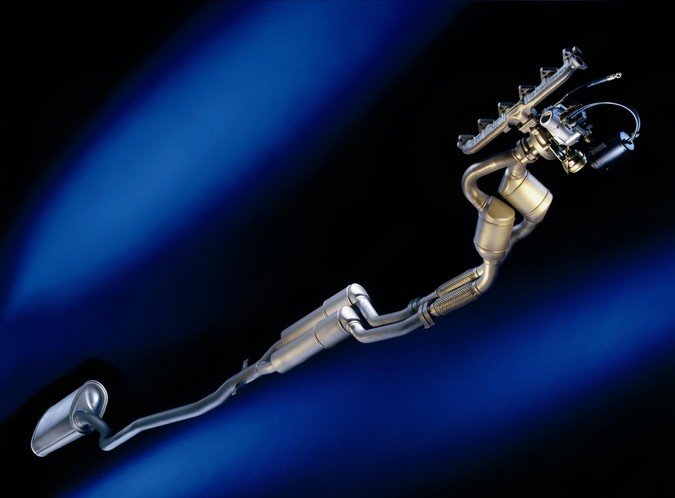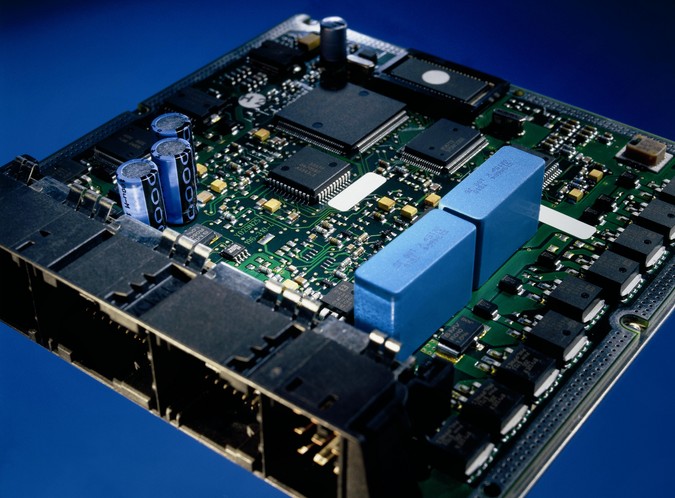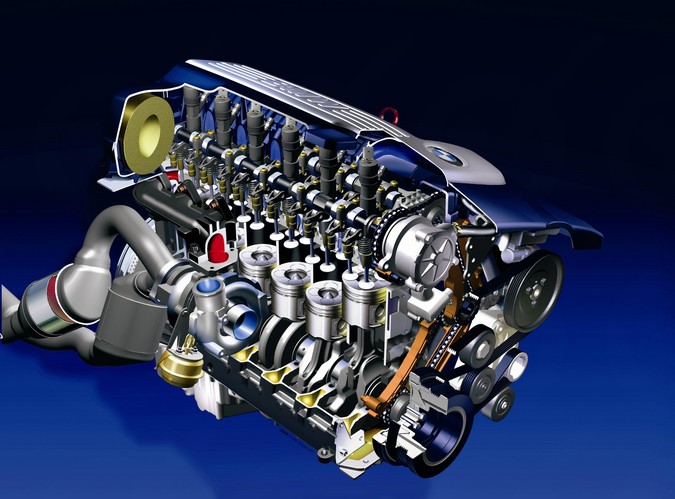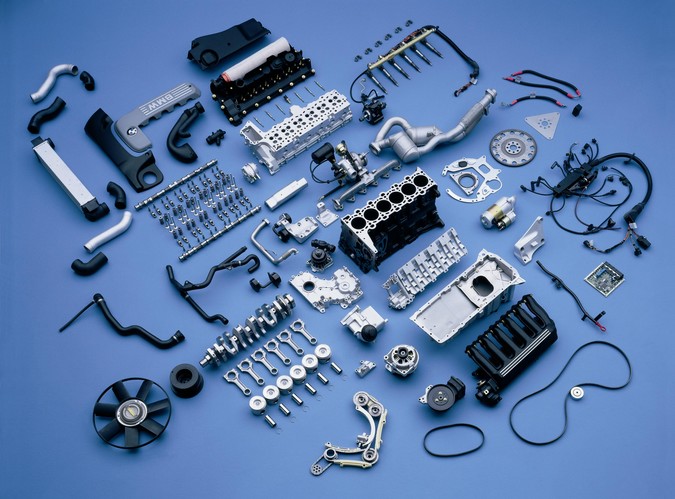M57 engine
A development of the M51 engine, the M57 engine had a grey cast iron crankcase and weighed 210 kg. Within the crankcase, the crankshaft was made from C38 mod and the cracked connecting rods were made from C40 mod.
The M57 engine had a second-generation common-rail injection system which used solenoid valve injectors, while fuel was supplied by a high pressure fuel pump (CP1). Within the combustion chamber, the injection nozzle was positioned centrally and the glow plug was on the inlet side. Furthermore, the cooling duct pistons and a central crown bowl.
The M57 had a light alloy cylinder head in which coolant flowed from the exhaust side to the inlet side. The chilled cast iron camshafts had a two-piece chain drive with a die-cast aluminium tensioning rail and plastic slide linings. The valves and springs for the M57 engine were shared with the M47; the four valves per cylinder were actuated by roller-type rocker arms with one hydraulic valve lash per valve. The plastic cylinder head cover combined the oil separator and intake silencer.
The M57 engine had a single turbocharger which featured a variable nozzle turbine (VNT, or variable geometry turbocharger, VGT). For emissions requirements, the M57 engine had electronically-controlled exhaust gas recirculation, a diesel-specific oxidation catalytic converter and a close-engine primary catalytic converter.
M57TU
The M57TU engine was introduced in 2002 and the M57TU TOP (or M57D30T1) followed in 2004. Used in the E60 535d and E61 535d, the M57TU TOP engine had a small, low-inertia turbocharger and a second larger turbocharger. The smaller turbocharger would operate at low engine speeds and, as engine speed increased, the larger turbocharger would start to operate. The larger turbocharger would initially serve as a pre-compressor for the smaller turbocharger, but would progressively become the primary turbocharger.
M57TU2
The M57TU2 (or M57D30O2) was first introduced in March 2005 in the E65 730d. The M57TU2 was significantly different from its M57 and M57TU predecessors in that it had:
- A new lightweight, aluminium crankcase. The closed-deck crankcase was manufactured from a chilled aluminium casting and had thermally joined cast iron bushes, externally cast ribs and sintered metal main bearing caps. The switch to an aluminium crankcase reduced mass by around 20 kg relative to its cat iron predecessor;
- A third-generation common-rail system injection system which used piezo-injectors and operated at 1600 bar. Piezo injectors were introduced because of their fast needle movements and short switching times, enabling multiple injections per combustion cycle. The piezo injectors were also lighter, more compact and required less power;
- Lighter camshafts that were produced using the Presta process. In the Presta process, a steel tube was rolled to create a ‘knurled’ area around its circumference and the camshaft lobes had splines which interfered with the knurling. The lobes were then pressed on and locked to the camshaft in their designated positions;
- An optimised electric boost pressure actuator for the VNT turbocharger; and,
- A cast iron exhaust manifold (previously metal).
TThe M57TU2 TOP or M57D30T2 engine was available from September 2006 and first offered in the E90 335d and E83 X3 3.0sd. Like the M57D30T1 engine, the M57D30T2 had small, low-inertia turbocharger and a second larger turbocharger.
| Engine | Model | Capacity | Peak power | Peak torque | DDE | Start | End |
|---|---|---|---|---|---|---|---|
| M57D25O0 | E39 525d | 2497 cc | 120kW | 350Nm | DDE4.0 | 03/00 | 02/04 |
| M57D30O0 | E39 530d | 2926 cc | 135kW | 390Nm | DDE4.0 | 09/98 | 03/00 |
| 142kW | 390Nm | DDE4.0 | 03/00 | 05/04 | |||
| E38 730d | 2926 cc | 135kW | 410Nm | DDE4.1 | 09/98 | 03/00 | |
| 142kW | 430Nm | DDE4.1 | 03/00 | 07/01 | |||
| E46 330d | 2926 cc | 135kW | 390Nm | DDE4.0 | 09/99 | 03/03 | |
| E53 X5 3.0d | 2926 cc | 135kW | 410Nm | DDE4.0 | 04/01 | 09/03 | |
| M57D25O1 | E60 525d, E61 525d |
2497 cc | 130kW | 400Nm | DDE509 | 04/04 | 03/07 |
| M57D30O1 | E65 730d | 2993 cc | 160kW | 500Nm | DDE506 | 09/02 | 03/05 |
| E46 330d | 2993 cc | 150kW | 410Nm | DDE506 | 03/03 | 09/06 | |
| E60 520d | 2993 cc | 160kW | 500Nm | DDE508 | 03/03 | 04/04 | |
| E83 X3 3.0d | 2993 cc | 150kW | 410Nm | DDE506 | 09/03 | 09/05 | |
| E53 X5 3.0d | 2993 cc | 160kW | 500Nm | DDE506 | 09/03 | 09/06 | |
| E60 530d, E61 530d |
2993 cc | 160kW | 500Nm | DDE509 | 04/04 | 09/05 | |
| M57D30T1 | E60 535d, E61 535d |
2993 cc | 200kW | 560Nm | DDE606 | 09/04 | 03/07 |
| M57D30O2 | E65 730d | 2993 cc | 170kW | 520Nm | DDE626 | 03/05 | 09/08 |
| E90 330d, E91 330d |
2993 cc | 170kW | 500Nm | DDE626 | 09/05 | 09/08 | |
| E60 530d, E61 530d |
2993 cc | 170kW | 500Nm | DDE626 | 09/05 | 03/07 | |
| E66 730Ld | 2993 cc | 170kW | 520Nm | DDE626 | 09/05 | 03/07 | |
| E53 X5 3.0d | 2993 cc | 160kW | 500Nm | DDE626 | 10/03 | 09/06 | |
| E92 330d | 2993 cc | 170kW | 500Nm | DDE626 | 09/06 | 09/08 | |
| E93 330d | 2993 cc | 170kW | 500Nm | DDE626 | 03/07 | 08/08 | |
| E70 X5 3.0d | 2993 cc | 173kW | 520Nm | DDE626 | 03/07 | 08/08 | |
| E71 X6 xDrive30d | 2993 cc | 173kW | 520Nm | DDE626 | 05/08 | 04/10 | |
| M57D30U2 | E90 325d, E91 325d |
2497 cc | 145kW | 400Nm | DDE606 | 09/06 | 02/10 |
| E92 325d | 2497 cc | 145kW | 400Nm | DDE606 | 03/07 | 03/10 | |
| E93 325d | 2497 cc | 145kW | 400Nm | DDE606 | 09/07 | 03/10 | |
| E60 525d, E61 525d |
2497 cc | 145kW | 400Nm | DDE606 | 03/07 | 09/10 | |
| M57D30T2 | E90 335d, E91 335d |
2993 cc | 210kW | 580Nm | DDE626 | 09/06 | 06/12 |
| E92 335d | 2993 cc | 210kW | 580Nm | DDE626 | 09/06 | 07/13 | |
| E83 X3 3.0sd | 2993 cc | 210kW | 580Nm | DDE626 | 09/06 | 08/10 | |
| E60 535d, E61 535d |
2993 cc | 210kW | 580Nm | DDE626 | 03/07 | 09/10 | |
| E63 635d, E64 635d |
2993 cc | 210kW | 580Nm | DDE626 | 09/07 | 07/10 | |
| E70 X5 3.0sd | 2993 cc | 210kW | 580Nm | DDE626 | 09/07 | 05/10 | |
| E71 X6 xDrive35d | 2993 cc | 210kW | 580Nm | DDE626 | 05/08 | 04/10 |
M57 swirl flaps
For models with the M57D25 engine (automatic transmissions only), M57D30 (automatic transmissions only), M57TUD30 and M57TU2D30 engines, the swirl flap mechanism in the inlet manifold consisted of butterfly valves within each individual inlet tract. These butterfly valves were secured to an actuating rod via two small screws and, over time, these screws could become loose. If this occurred, the screws could be drawn into the cylinder and cause significant damage to the piston, cylinder head and valves. If a screw were to pass through the exhaust valve, it could then damage the turbocharger. As a result of this problem, a common modification is to remove the swirl flaps and replace them with blanking plates. From 2004 to 2007, BMW introduced larger diameter spindles (made from plastic) and larger screws, though these engines were not immune to failure. Around 2006, it is understood that plastic swirl flaps were introduced to reduce the likely extent of damage.
